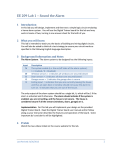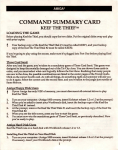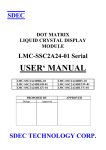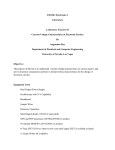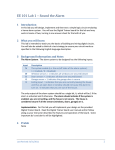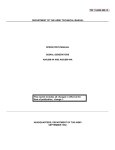Download Oscilloscope Usage
Transcript
USC Electrical Engineering ELCT 301 Project #1 Oscilloscope Usage Objective The main purpose of this laboratory exercise is to learn how to use the laboratory equipment and in particular the TDS-series digital oscilloscope. We will use a mechanical switch as an example to make measurements on and will build a switch debouncer circuit. We will also make some measurement on an OPAMP circuit. Background Read pp. 1-75 of the User Manual of the TDS 1000-series oscilloscope on the 301 web page. Review material on Schmitt triggers in your electronics book. Mechanical Switches When you operate a mechanical switch, the contacts usually bounce for up to a millisecond after closure. Large switches can bounce for up to 50ms. This can wreak havoc in circuits that are sensitive to the multiple transitions, such as edge triggered logic circuits. For example suppose you have a counter triggered by a pushbutton switch. Due to the bounces the counter may be incremented by more than one each time you press the button. This is a well-known problem of mechanical switches. Basically, switch bouncing is unavoidable, so the solution is to make the circuit insensitive to the multiple transitions. Circuits that accomplish this are called switch debouncer circuits. As is usual in electronics, there are a number of dedicated ICs to perform this function, such as the 4490 "hex contact bounce eliminator." These circuits are ubiquitous. Probably you use every day a device that has about a hundred of these circuits. Prelab Answer the following questions in your lab notebook. • Oscilloscope nomenclature. Write in your lab notebook definitions for sampling rate, analog bandwidth, record length (memory depth), vertical resolution. © 2003 by E. Santi 1 USC Electrical Engineering ELCT 301 Project #1 • • • • • • • Find out (in the scope manual) numerical values for sampling rate, analog bandwidth, record length (number of sampling points) and vertical resolution for the TDS 1000 scope. What is the difference between auto trigger and normal trigger? What is the single shot (single sequence) trigger? The oscilloscope sampling rate changes with the time scale. For the following time scale settings, determine sampling rate and number of stored points for the TDS 1000 scope. Keep in mind that the scope has 10 horizontal divisions. 5ns/div, 50ns/div, 250ns/div, 500ns/div, 5μs/div, 1ms/div. The Spice file BounceSwitch.cir contains a simulation of the switch circuit of Fig. 1 for the case of a bouncing switch. Perform a simulation of the switch debouncer circuit of Fig. 2 in Spice. Use as a starting point the BounceSwitch.cir file on the web page. Your debouncer circuit should be connected to node 1 of the provided circuit. Select R2 = 1kΩ and find the smallest capacitance value for C1 that eliminates the bounce. Use the 7414 subcircuit contained in the eval.lib library. Put in your lab notebook a plot of the voltages at points A, B and C for C1=0 and for the smallest value that eliminates the bounce. Now put a capacitor value 100 times bigger and run a simulation. What is the effect on the output of the Schmitt trigger? Examine the provided Spice circuit BounceSwitch.cir, draw the electrical circuit and explain how the circuit operates in your own words in your lab notebook. Hint: find out what a PWL source does in Spice. The Spice handout contains this information. Give a definition of propagation delay of a logic gate. Project Build a simple switch circuit. Observe the switch bounce effect. Build a switch debouncer using a Schmitt trigger. In the process use several of the scope capabilities. In Lab Build the simple switch circuit shown in Fig. 1. Acquire the switch closing (turn on, high-to-low) and switch opening (turn off, low-to-high) transitions with the scope in single shot mode. For which transition do you expect to see bouncing? Do this at a 10ms/div time scale. Zoom in on the saved waveform to look for bounces. Do you see any? Change the time scale to 40μs/div and repeat. Probably you were not able to see the bounces at 10ms/div. Explain why. Include the plots in your report. Acquire three different turn on transitions and display them on the same scope view by saving two of the acquisitions to the reference waveforms A and B. Include the plot in your report. © 2003 by E. Santi 2 USC Electrical Engineering ELCT 301 Project #1 Acquire waveform data (the actual data points, not a screen image) for the last measurement and save it in a .csv file, which is an Excel file type. Verify that the number of acquired points for a waveform is as advertised in the scope manual. +5V R1 1kΩ S1 Fig. 1. Mechanical switch circuit. +5V R1 +5V 1kΩ R2 B A C 74HC14 S1 C1 Fig. 2. Switch debouncer using a Schmitt trigger. Build the switch debouncer shown in Fig. 2. Include in your report plots of the turn on and turn off transitions at points A, B and C. Connect a second Schmitt trigger at point C of Fig. 2. Measure the propagation delay. Produce a scope picture showing the waveform at point C and at the output of the Schmitt trigger that you added. Use cursors to measure the propagation delay. © 2003 by E. Santi 3 USC Electrical Engineering ELCT 301 Project #1 Build the unity-gain inverting amplifier shown in Fig. 3 using the LM741 OPAMP. Measure the input and output voltage for a 50-mV sine wave at frequencies of 5kHz, 50kHz, 500kHz and 5MHz. Include plots in your report. Describe the results. Is the gain constant? If not, how does it change? Can you explain the result? Measure the input and output for an 8-V 30-μs pulse and include the measurement in your report. Is the output a faithful replica of the input pulse? Can you explain what you observe? R2 10kΩ +15V C1 100nF A R1 LM 741 + 10kΩ B C2 100nF -15V Fig. 3. Unity-gain inverting amplifier with 100nF bypass capacitors C1 and C2 © 2003 by E. Santi 4






